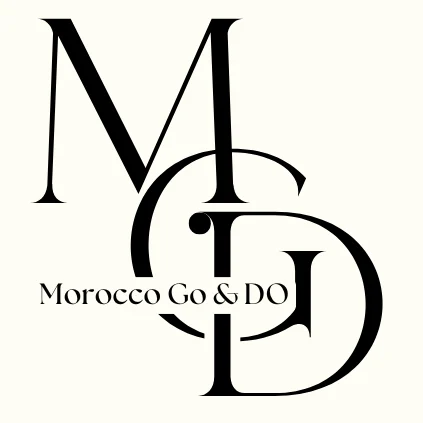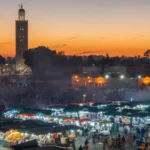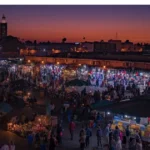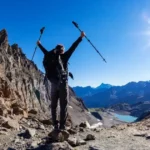Morocco
Where to Go & What to Do
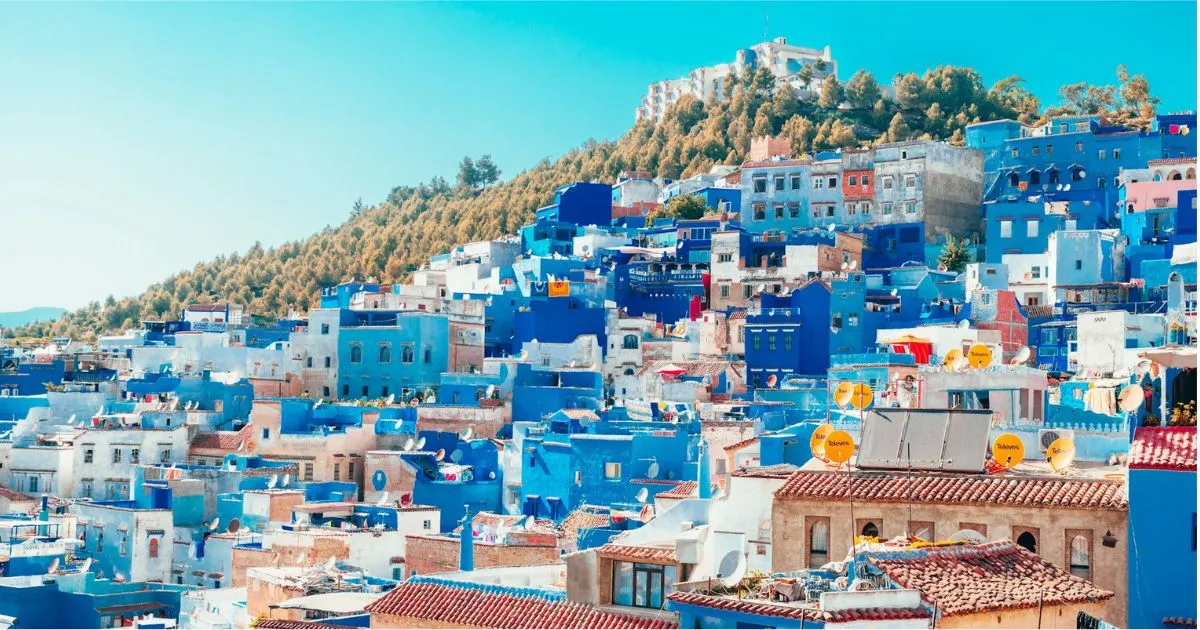
Chefchaouen, known as Morocco’s blue city, is a must-see. Its blue buildings and lively vibe attract many. Located in the Rif Mountains, it combines natural beauty with rich culture.
There’s plenty to see in Chefchaouen, from its colorful streets to traditional buildings. The city’s calm adds to its charm, making it perfect for exploring. This guide will help you discover the best of Morocco’s blue city.
Chefchaouen’s streets are filled with history and vibrant culture. The blue alleys welcome visitors with their calm and beauty. Walking through, each new blue shade catches the eye, showing the city’s artistic side.
Exploring Chefchaouen’s blue alleys is a unique experience. Every corner has quaint shops and local artisans, adding to the lively vibe. The streets lead to hidden spots like cafes and art displays.
The locals’ skillful craftsmanship is seen everywhere. It matches the city’s famous blue colors perfectly.
The streets of Chefchaouen are more than just blue. They showcase stunning Moroccan architecture. The facades are adorned with traditional tiles and flower boxes.
The architecture features large doors and ornate iron windows. These reflect the city’s cultural history. Each part of the design blends with the surroundings, making Chefchaouen a beautiful sight.
The history of Chefchaouen is quite fascinating. It was founded in the 15th century as a fortress. This was to fight against colonial forces. Its location in the Rif Mountains made it a safe place for those against outside control.
The blue color of Chefchaouen’s buildings and streets has a special meaning. It’s thought that Jewish refugees brought this color in the 1930s. They saw blue as a symbol of heaven and peace.
This tradition has lasted for many years. It has made Chefchaouen famous as the blue city.
Local traditions make Chefchaouen’s social life lively. Festivals in Chefchaouen are key to showing off cultural practices. For example, the Chefchaouen Festival features music, art, and food.
These events show the city’s creativity. They also bring people together, showing the city’s cultural richness.
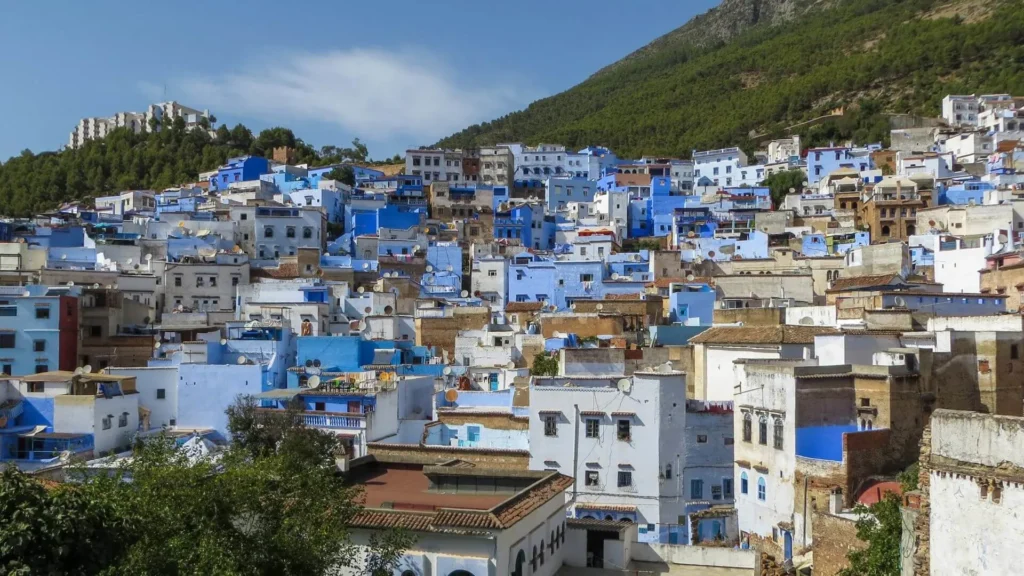
Exploring Chefchaouen, the blue city, reveals many must-see spots. Each place offers a unique experience, showing the rich culture of this area.
The Kasbah Museum is a key spot for learning about Chefchaouen’s history and culture. It’s filled with artifacts in an 18th-century kasbah, beautifully restored. It’s a great place to start, offering insights into Moroccan architecture and culture.
The Grand Mosque is famous for its tall minaret and traditional design. It’s a symbol of Islamic culture in the city. People come to admire its beauty and to pray.
The Ras El Maa Waterfall is perfect for nature lovers. It’s a peaceful spot outside the city. Surrounded by greenery, it’s great for walks and relaxation, making it a top attraction in Chefchaouen.
The beauty of Chefchaouen’s nature is a big draw for both locals and tourists. It’s nestled in the Rif Mountains, offering a gateway to outdoor adventures. The area’s diverse landscapes make it ideal for those seeking adventure and stunning views.
Hiking in the Rif Mountains has trails for all skill levels. You can enjoy easy walks in lush valleys or tackle more challenging climbs. Each trail reveals the area’s natural beauty and unique plants and animals.
As you hike, you’ll find amazing viewpoints. Every step shows you a new side of the region’s beauty. The trails also help you understand the Rif Mountains’ ecological importance.
Visiting the Spanish Mosque is a must. It offers some of the best views in the area. From here, you can see Chefchaouen and its beautiful surroundings.
Photographers and nature lovers will love the views. The blue buildings against the green landscapes are breathtaking. This spot is perfect for taking a moment to enjoy the peace and beauty of nature.
Shopping in Chefchaouen is a journey into vibrant culture and art. Traditional markets and souks are filled with local handicrafts. These show the talent and creativity of Moroccan artisans.
The markets in Chefchaouen offer a real shopping experience. They are full of colorful stalls and lively talks. Souks are known for their creative crafts and unique items.
Visitors will see stunning textiles, pottery, and handwoven rugs. Each piece tells a story of Chefchaouen’s heritage. Talking with local merchants adds to the fun, as bargaining is a big part of souk culture.
The souvenirs from Chefchaouen make for a memorable shopping trip. You can find hand-painted ceramics, artisan jewelry, and local spices. These items reflect the region’s unique identity.
These treasures let tourists take a piece of Chefchaouen home. They ensure the charm of the destination stays with them long after they leave.
The food in Chefchaouen is a mix of rich traditions and vibrant tastes. Visitors can try many dishes that show off local ingredients and cooking methods. This area is a blend of flavors, appealing to both food experts and newcomers to Moroccan cuisine.
Tagine and fluffy couscous are must-try dishes. B’stilla, with its layers of pastry and seasoned meat, is also a favorite. These dishes use bold spices and herbs, making dining unforgettable.
Eating in Chefchaouen is an adventure, with many restaurants to choose from. Casa Hassan and Restaurant Tissemlal are known for their authentic flavors and atmosphere. These places offer great food and service, diving diners into the heart of Chefchaouen’s culture.
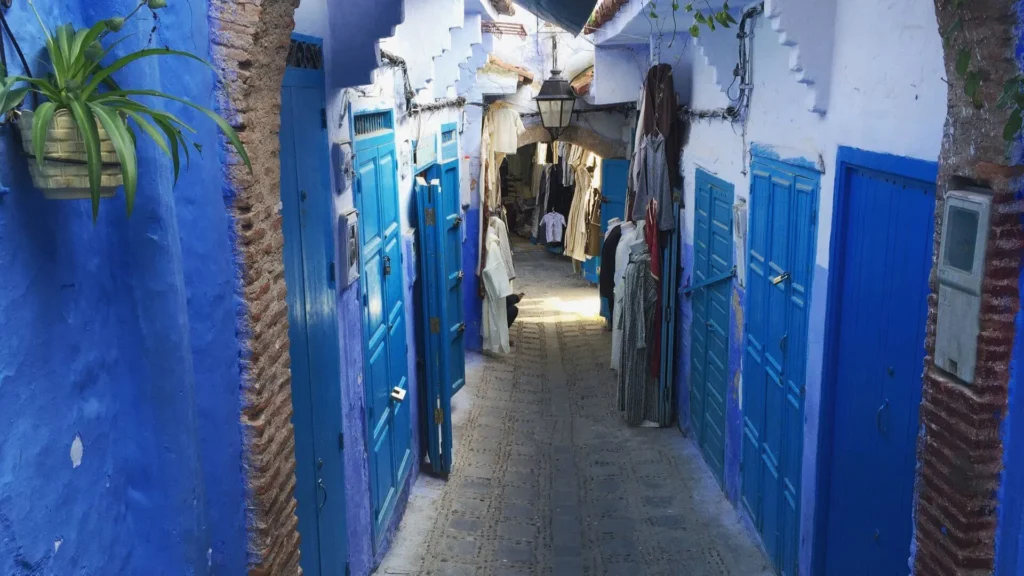
For those who love nature, Chefchaouen offers a great escape from city life. It’s famous for the stunning Akchour Waterfalls. These waterfalls attract many visitors looking for a day of fun and calm.
Visits to Chefchaouen often include the beautiful Akchour Waterfalls, just a short drive away. The trip offers scenic hiking trails that show off the Rif mountains’ beauty. These trails are for all hikers, from beginners to experts.
At the waterfalls, you can do many things, like:
The waterfalls are not just pretty but also home to many plants and animals. Each trip to Akchour Waterfalls is a special experience. It makes Chefchaouen a top spot for outdoor fun.
Getting to Chefchaouen is easy with many travel options. You can take a bus or drive, reaching the city’s blue streets quickly. Knowing the best times to visit makes your trip better, letting you enjoy all Chefchaouen has to offer.
There are several ways to get to Chefchaouen. Here are the main ones:
The best times to visit Chefchaouen are spring and autumn. This is from March to May and September to November. The weather is mild, perfect for outdoor fun and seeing sights. Planning your visit during these times means you’ll avoid bad weather and enjoy the culture and views fully.
Travelers visiting the beautiful blue city will find many places to stay. There are fancy hotels and cozy guesthouses for all budgets. Each option aims to meet different needs.
Hotels in Chefchaouen are known for their comfort and Moroccan hospitality. Places like Hotel Parador and Riad Ras El Maa offer great amenities. They also have a warm welcome.
Guesthouses, run by local families, offer a peek into the culture. Staying here can make your trip special. You might enjoy home-cooked meals and personal service.
For a unique experience, try staying in riads or eco-lodges. These places show off the area’s traditional architecture and culture. They offer stunning views and a chance to explore the local area.
These stays are perfect for those who want to dive deep into Chefchaouen’s magic. They make your journey unforgettable.
Chefchaouen is a special place where beauty, history, and culture come together. It’s a blue city in Morocco that draws you in with its beautiful streets, delicious food, and stunning views. Every part of Chefchaouen makes your visit unforgettable.
This travel guide shows there’s more to Chefchaouen than its famous blue alleys. You can dive into local traditions, see the beauty of the Rif Mountains, and try tasty dishes in restaurants and cafés. These experiences make visiting Chefchaouen truly special.
This guide is a great tool for anyone wanting to explore Chefchaouen’s magic. It helps you make the most of your time there. Chefchaouen is a place that makes you want to come back, with its unique spirit and lively culture.
Chefchaouen is known as the blue city in Morocco. It’s famous for its blue buildings, beautiful streets, and rich culture. People love to wander its alleys and enjoy the local vibe.
Spring (March to May) and autumn (September to November) are the best times. The weather is mild, perfect for exploring outdoors.
You must try tagine, couscous, and “B’stilla.” These dishes offer a true taste of Moroccan food.
Don’t miss the Kasbah Museum for history. The Grand Mosque is stunning. And the Ras El Maa Waterfall is peaceful for nature lovers.
Try hiking in the Rif Mountains. Or visit the Akchour Waterfalls for picnics and nature.
You can take buses from major cities or rent a car. Both offer easy ways to get there.
The markets and souks have local crafts like rugs, pottery, and textiles. They’re great for finding unique gifts.
You can choose from luxury hotels like Hotel Parador to cozy guesthouses and riads. There’s something for every budget and taste.
Chefchaouen celebrates the annual Chefchaouen Festival. It’s a time for music, art, and food, making it fun for visitors.
The Moroccan government works hard to keep tourists safe. This is because tourism is very important for the country’s economy. But, travelers should still watch out for small thefts, cultural mistakes, and health issues. Knowing about these risks can help make your trip safer and more fun.

This section covers key safety aspects in Morocco, like cultural norms, crime rates, and tips for women travelers. Knowing Morocco cultural etiquette helps travelers avoid cultural misunderstandings and enjoy their stay.
Respecting local customs and traditions is crucial in Morocco. Dress codes and social behavior are important. Women should dress modestly, showing respect for Morocco cultural etiquette.
Public displays of affection are frowned upon. It’s best to greet people with “Salam Alaykum,” which means ‘peace be upon you.’
Violent crime in Morocco is rare, but travelers should stay alert, especially in tourist areas. Petty theft, like pickpocketing, is common in crowded places. Keeping valuables safe and being mindful of your surroundings helps prevent theft.
Recent data shows most crimes in Morocco are petty theft. So, it’s wise to be cautious.
For Morocco safety for solo female travelers, there are special considerations. Women might face harassment. Wearing modest clothing and traveling with others can help reduce these risks.
Understanding Morocco cultural etiquette helps women navigate social situations safely. This makes their trip both safe and enjoyable.
To answer if is Morocco safe for Americans, we need to look at many factors. The Morocco U.S. travel advisory from the U.S. Department of State is key. It tells us about safety tips and possible dangers for American tourists.
Morocco is seen as a friendly place for American visitors. The people there are very welcoming to guests from other countries. But, we must also think about the political situation, the stability of the area, and Morocco’s relationship with the U.S. These things can affect how safe Americans feel.
In the past, American tourists’ safety in Morocco hasn’t been a big problem. But, it’s still important for Americans to be careful and know what to do in emergencies. It’s best to keep a low profile and not do anything that might attract unwanted attention.
The safety advice often changes based on the political and stability situation. So, it’s important for travelers to keep up with the latest news and advisories about Morocco. This will help them decide if is Morocco safe for Americans.
Travelers often wonder about the safety in Moroccan cities. This section looks at the safety in major cities like Casablanca and Marrakech. We also cover other notable cities.
Many ask is Casablanca Morocco safe. As the largest city, Casablanca has a strong police force. There are even tourist police to help visitors. But, it’s still wise to watch out for petty theft in crowded places.
Keeping valuables safe and avoiding dark places at night can help. These simple steps can make your visit safer.
The safety in Morocco Marrakech is also a big concern. Marrakech is famous for its lively markets and old sites. It attracts many tourists every year.
The city has taken steps to keep visitors safe. There are more police in tourist areas and cameras to watch over them. But, it’s still important to be careful in busy places like Jemaa el-Fnaa. Pickpocketing can happen there.

By staying alert and following local advice, you can have a safe trip to Marrakech.
Other Moroccan cities like Fez, Tangier, and Rabat also have their own safety levels. Fez’s narrow medina means you need to keep an eye on your belongings. Tangier, being a port, has strict security at its transport points.
Rabat, the capital, has more government security. This makes it a safer place. But, it’s always good to follow basic safety tips everywhere you go.
| City | Key Security Features | Traveler Tips |
|---|---|---|
| Casablanca | Tourist police, regular patrolling | Avoid isolated areas, secure valuables |
| Marrakech | Surveillance systems, enhanced patrolling | Be wary of pickpockets, stay in well-lit areas |
| Fez | High security in medina | Stay vigilant with personal items |
| Tangier | Security at transport hubs | Exercise caution at ports |
| Rabat | Government security presence | Follow local advisories |
Traveling to Morocco is a chance to see new cultures and beautiful places. To make your trip safe and fun, know about local places to stay, how to get around, and health tips.
Choosing Morocco accommodations safety means many options. You can pick from fancy hotels to cozy riad guesthouses. Hotels have better security, like 24-hour watch and safe doors. Riads offer a close feel with personal service. Make sure your place is safe and in a good area.
Knowing about transportation in Morocco helps keep you safe. Moroccan cities have taxis, buses, and trains. For safety, take registered taxis, especially petit taxis for short trips and train services for longer ones. If you rent a car, be careful because roads and driving can be different.
| Mode of Transport | Safety Tips |
|---|---|
| Taxis | Make sure it’s registered; agree on the fare first. |
| Buses | Choose known and safe bus companies; keep things safe. |
| Trains | First-class tickets offer more comfort and safety. |
To stay healthy in Morocco, take some steps. Make sure you have the right shots, like for hepatitis A, typhoid, and rabies. Drink bottled water and be careful with street food. Also, get travel insurance that covers health and emergencies.
Planning a trip to Morocco? It’s key to know the Morocco visa requirements and legal travel considerations. Morocco has clear rules for visitors, especially about visas and entry. Knowing these rules helps ensure a legal and smooth trip.
U.S. citizens wondering if they need a visa for Morocco can relax. Americans can visit Morocco for up to 90 days without a visa for tourism or business. Just remember to bring a valid passport with at least six months left before it expires.
For stays longer than 90 days, Americans need to get a visa from the Moroccan consulate or embassy. If you plan to work, study, or research, you’ll need the right visa and permits. Make sure to follow the Morocco visa requirements closely.
Remember all legal travel considerations too. This includes having return tickets and enough money for your stay. Also, follow local laws, like registering with authorities for longer stays. This keeps you in line with Morocco’s laws.
| Visa Type | Duration | Requirements |
|---|---|---|
| Tourist Visa | Up to 90 days | Valid Passport, Return Ticket, Sufficient Funds |
| Business Visa | Up to 90 days | Valid Passport, Business Invitation |
| Long-term Visa | Beyond 90 days | Visa Application, Appropriate Documentation |
| Student Visa | Study Period | Valid Passport, Acceptance Letter |
Understanding safety in Morocco means knowing the culture, crime rates, and travel rules. Morocco is mostly safe for visitors, including women and Americans. But, it’s important to stay alert and use common sense.
Cities like Casablanca and Marrakech have their own safety levels. While they are generally safe, some areas or times need extra care.
Crime rates show that small thefts are common. But, these can often be avoided by being careful and aware of your surroundings. Women should respect local customs and stay alert to feel safe.
Legal issues, like visa rules for Americans, are clear. This makes entering Morocco easier.
Staying safe in Morocco means always being ready and informed. Choose good places to stay, use safe transport, and follow health advice. This helps you face any problems.
Travel advice suggests doing your homework and keeping up with safety alerts. This way, you can have a safe and fun trip in Morocco.
Morocco’s safety for travelers depends on several factors. These include the country’s stability, crime rates, laws, and cultural norms. Travel advisories and data from security agencies are good starting points.
With its rich history and diverse culture, Morocco is a popular but cautious destination. The local government works hard to keep tourists safe.
It’s important to understand and respect Moroccan culture. This means following dress codes, especially in conservative areas. Also, knowing local social etiquette helps avoid problems and ensures a better trip.
Petty theft is common, especially in crowded places and tourist spots. To stay safe, be vigilant, keep your belongings secure, and be aware of your surroundings.
Many women travel safely in Morocco. However, harassment can happen. Solo female travelers should dress modestly, avoid isolated spots, and be cautious with strangers.
Knowing the local culture can greatly improve safety for women.
Morocco welcomes American tourists. But, it’s wise to check the U.S. Department of State’s travel advisory. Staying discreet and following local customs and laws helps ensure safety.
Casablanca has areas with higher safety concerns. The presence of law enforcement and tourist police helps. Still, travelers should be careful, especially in crowded and tourist-heavy zones.
Marrakech is generally safe for tourists. But, watch out for pickpockets and scammers, especially in the Medina. Following safety tips and staying alert ensures a secure visit.
Cities like Fez, Tangier, and Rabat have their own safety tips. While safe, it’s good to research specific advice for each city. Following standard travel safety measures is also important.
Morocco offers various accommodations, from riads to hotels. Safe options include those recommended by travel agencies or well-reviewed online. Make sure your accommodation has good security.
Morocco has safe transportation like taxis, buses, and trains. Licensed taxis and day travel are safer. Avoiding crowded buses and rural areas also helps.
Be aware of health risks and take precautions like vaccinations. Ensure food and water safety and have travel insurance. Carry basic medical supplies and know nearby hospital locations.
Americans and Uk citezens don’t need a visa for up to 90 days but they need a passport valid for six months. For longer stays, a visa is needed. Knowing the visa process and required documents is crucial.
